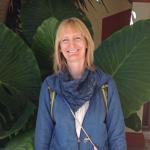Select monthly updates from our team of restoration ecologists, entomologists, plant ecologists, and researchers.
The Xerces Society manages the largest pollinator conservation program in the world. We work with farmers, gardeners, land managers, agency staff, and others to create habitat for bees, butterflies, and beneficial insects—and hundreds of thousands of acres of flower-rich habitat have been planted. We also offer certifications: Bee Better Certification for farmers and food companies who are committed to supporting pollinator conservation in agricultural lands, and Bee City USA and Bee Campus USA certifications for cities and colleges dedicated to making the world safer for pollinators.
With staff based in more than a dozen states, and offering a diverse array of expertise, it can be challenging to summarize the impactful work being done by our team of restoration ecologists, entomologists, plant ecologists, and researchers. Therefore, we have compiled select pollinator conservation program updates into monthly digests. November’s featured staff hail from Minnesota, Indiana, and California, and have been conducting training and outreach events, helping General Mills to implement their plan to plant 3,300 acres of pollinator habitat, and monitoring farm habitat plantings in the San Joaquin Valley.
Conducting Training and Outreach—and an Endangered Bumble Bee Sighting!
Karin Jokela, Farm Bill Pollinator Conservation Planner
Late summer was chock full of training and outreach events for me. In several cases, I was the lead instructor, but they all came to fruition thanks to some amazing partnerships. Together with the Board of Water and Soil Resources (BWSR), we put on two full-day pollinator habitat planning and seed mix design courses geared toward conservation planners from the Natural Resources Conservation Service (NRCS) and Soil and Water Conservation Districts (SWCD)—one in Austin, Minnesota and one in Marshall, Minnesota. These included morning classroom sessions followed by afternoon outings to young pollinator plantings on local farms. They generated great discussions about technical tools and the practicalities of habitat restoration, and we’re already planning to do two similar trainings in 2019 for field staff in the northern parts of the state.
I was also involved in planning two pollinator short courses in Dane County, Wisconsin. Friends of Silverwood County Park (FOSP), a nonprofit whose mission is to support sustainable agricultural education at Silverwood County Park, received a grant to provide training to farmers and landowners on planning and implementing pollinator habitat. With the help of my tenacious collaborator and FOSP board member Emily Halapatz, we hosted two well-attended workshops with guest speakers from NRCS, Pheasants Forever, and University of Wisconsin Extension. Like the Minnesota workshops, we spent the morning in classroom sessions, and then went as a group to explore existing pollinator habitat on farms.
Our first workshop was hosted at Silverwood County Park. This place has a diverse landscape, featuring small garden plots, organic agronomic crops, newly established pollinator meadows, and approximately 60 acres of woodlands sloping down to Rice Lake. As we toured the fields and gardens, we practiced bee identification using the Upper Midwest Community Science Monitoring Guide. We found squash bees, sweat bees, and lots of bumble bees—including the endangered rusty patched bumble bee! The observation was just one of several in the Madison area this summer, but this particular sighting represented an important new location in their range (and was reported to Bumble Bee Watch). It was a special day for the workshop attendees who were able to see the rare bumble bee, and the FOSP board members were thrilled to have yet another demonstration of the benefits of sustainable agriculture on their property!
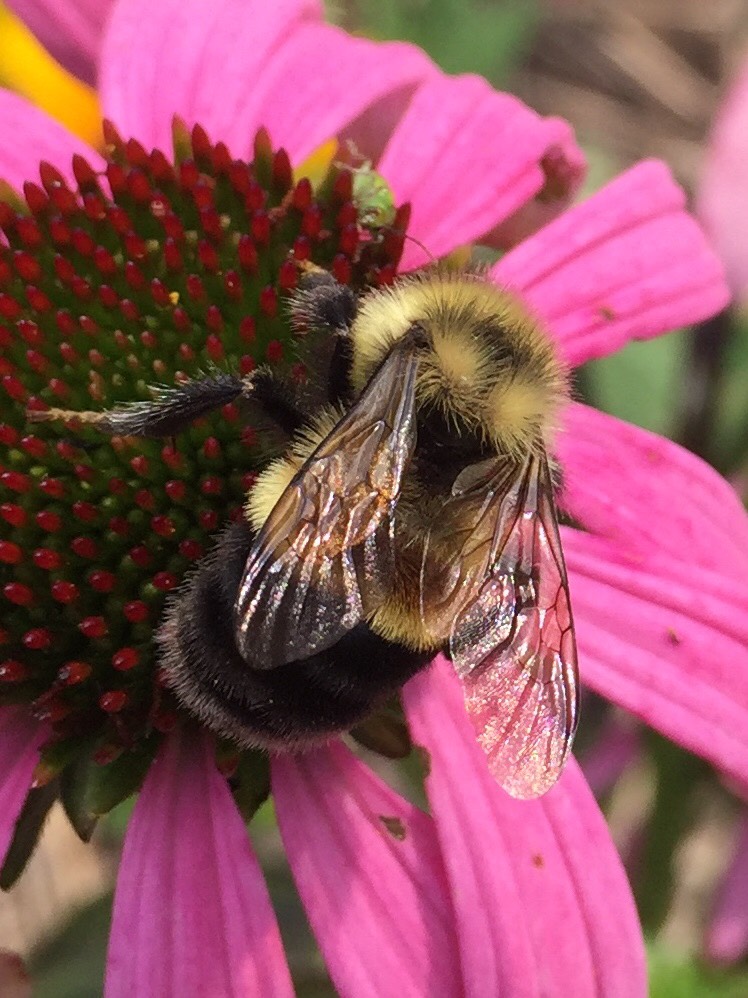
Building Pollinator Habitat in the Northern Great Plains
Stephanie Frischie, Agronomist and Native Plant Materials Specialist
The Xerces Society and General Mills have partnered to plant 3,300 acres of perennial pollinator habitat in the Northern Great Plains among the farms where the oats for Cheerios are grown. We are two years into our five-year plan and have planted 1,520 acres so far.
If you’re thinking, “Pollinator habitat for oats? I thought oats were wind pollinated,” then you’ve had an astute thought! As with most of the grass family, oats’ pollen grains and female flower parts are adapted for wind pollination. But there is a diversity of crops grown in rotation with oats. Some are wind pollinated (wheat and corn), some are both self-pollinated and insect pollinated (soybeans and flax) and others are solely pollinated by insects (canola, alfalfa seed, tame pasture, and native grasslands).
Growing a range of crops promotes resilience in the face of poor crop years, weather, or fluctuating prices. Furthermore, a diversity of plants helps to support healthy pollinator populations, by providing a variety of pollen and nectar resources over the seasons and across years.
Planning, planting, and maintaining quality pollinator habitat takes many partners. We are working with over 40 farmers in the US and Canada through this General Mills partnership. The collaboration also involves SWCD and NRCS staff, other conservation groups, grain elevators, and researchers. Because seeds are a key piece of establishing habitat, seed producers are part of our efforts, too.
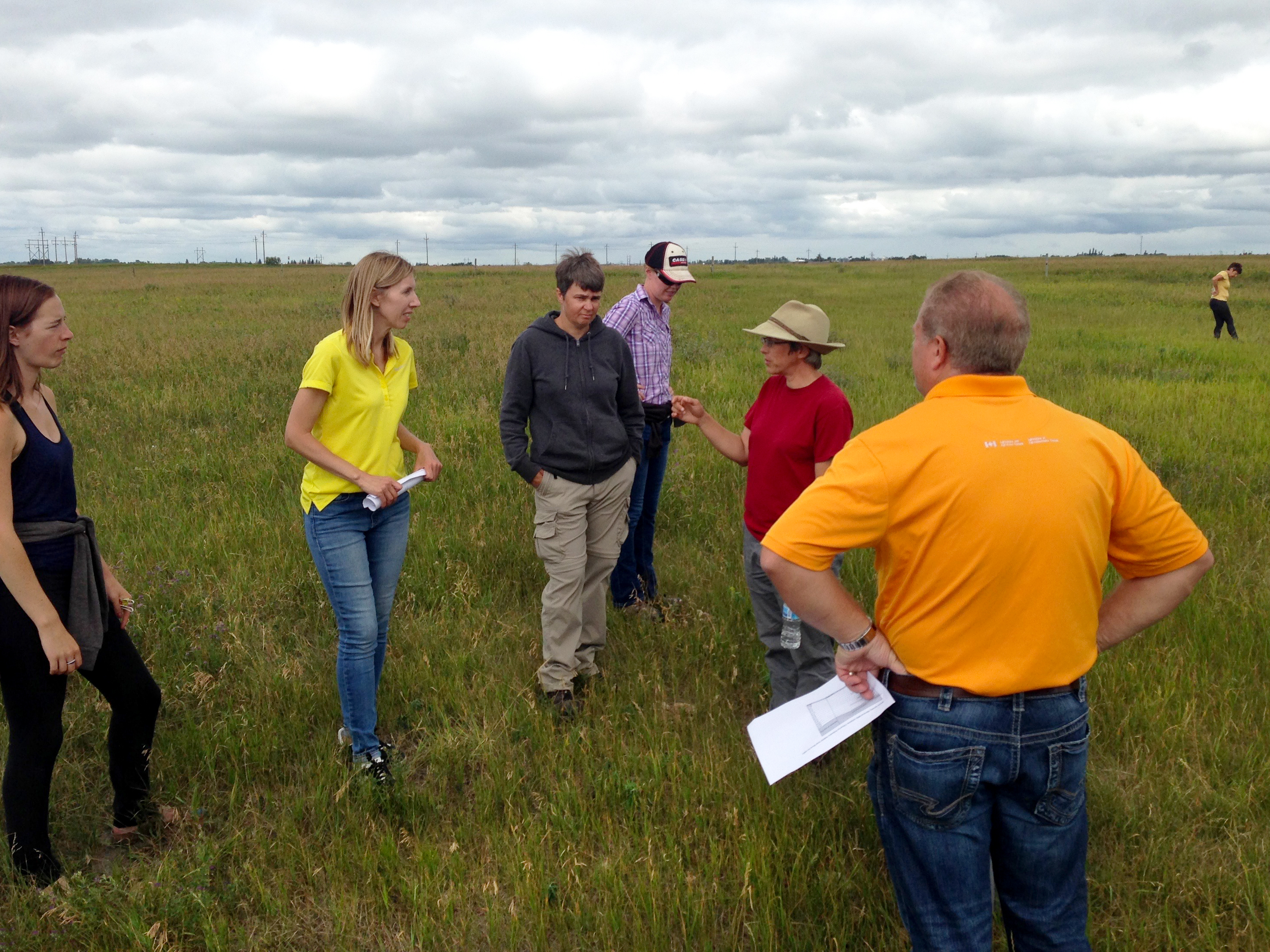
Pollinator habitat supports more than pollinators; it provides food and shelter for other wildlife including beneficial insects, monarch butterflies, birds, mammals, reptiles, and amphibians. It can also support livestock when managed with the needs of both in mind. Technical staff at the Manitoba Beef and Forage Initiative (MBFI) research site near Brandon, MB wanted to improve the forage quality of degraded pasture. The pasture had become dominated by grasses and more legumes and forbs (broadleaf plants) were desired, not only for cattle forage but also to provide nectar and pollen for pollinators.
We jointly designed an experiment to test ways to interseed diversity back into these paddocks. We developed a seed mix with 4 tame legume, 3 native legume, and 8 native wildflower species. In the spring, staff knocked back the pasture grasses with herbicide. Then they used two trial methods for adding the seed mix to the pasture. In one method, they used a seed drill to shallowly plant the seeds in the sod. The other method was to sprinkle the seed mix over the sod by hand, fence off the plot, and move cattle into the plot at a high stocking rate for a short period of time so their hooves worked the seeds into the sod. Local staff monitor the forage diversity and establishment success of each interseeding method.
To come up with the seed mix for that interseeding trial, I sourced seeds from four separate companies in Manitoba and one in Alberta. This wasn’t the most convenient way to get seeds, but it was the only way to get the diversity of species we needed for optimal pollinator habitat. Another exciting part of this multi-year habitat program is that I can plan and work with seed companies to have them produce more seeds of more species that are valuable for pollinators. I’ll mention two companies as examples. Prairie Originals, located north of Winnipeg in Selkirk, MB grows seeds of more than 100 species native to Manitoba. Owner Kelly Leask was already in the process of expanding the size of their production fields when I contacted her for seeds for pollinator habitat.
Across Manitoba to the west, near Roblin, John Skinner has been growing and collecting native seeds for nearly 20 years for his business, Skinner Native Seeds. He has been growing about 10 species in large production fields. This past year, he collected seeds from over 40 additional species to increase the variety of seeds he will be producing. Both companies grow seeds of native milkweeds and we include these in the pollinator habitats. In coming years, it will be great to have more seeds available of these Manitoba ecotypes to use for the General Mills program.
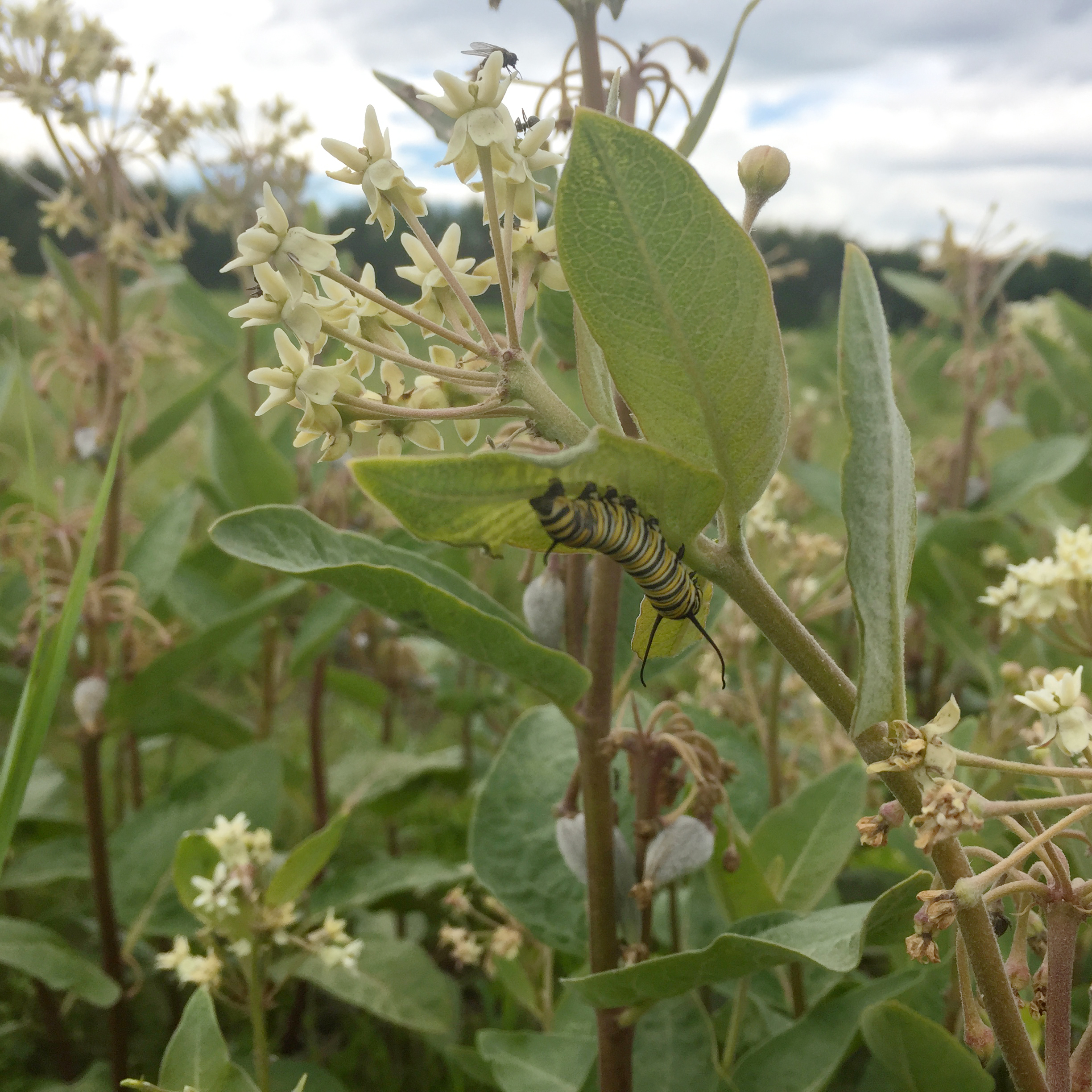
Farm Habitat Monitoring in the San Joaquin Valley
Kathryn Prince, Farm Bill Pollinator Conservation Planner
In November, temperatures are dropping and rain is on the way, which means the season for planting pollinator habitat in California’s San Joaquin Valley is underway. With the support of the U.S. Department of Agriculture Natural Resources Conservation Service (NRCS), I am visiting habitat that has been installed on farms across the valley. At each site, I show up armed with a clipboard and bug net to monitor the establishment success of native plantings when they’re planted and over time as they mature. I also monitor and advise on the maintenance of the plantings.
The information I’m gathering from these visits will provide valuable insight into the plant species that perform best in farmland settings, which species don’t do well, and how satisfied farmers are with their new habitat. I also take some time during each site visit to monitor the beneficial insect community. Critters like hoverflies, wild native bees, and beneficial predatory beetles roam amongst the native plants, now that they have replaced bare dirt and weeds!
One such success story is a hedgerow planting on a Fresno County farm that grows Asian fruits and vegetables. In October this farm became the site of a Hmong language field day for local small-scale farmers. I was on hand to lead participants in an exploration of the hedgerow, where they learned about how they can plant habitat to support beneficial insects on their own farms. As farmers in the valley adopt pollinator-friendly practices such as flowering hedgerows, my hope is that wild insects will continue have a place here—for the good of wildlife and farmers alike.
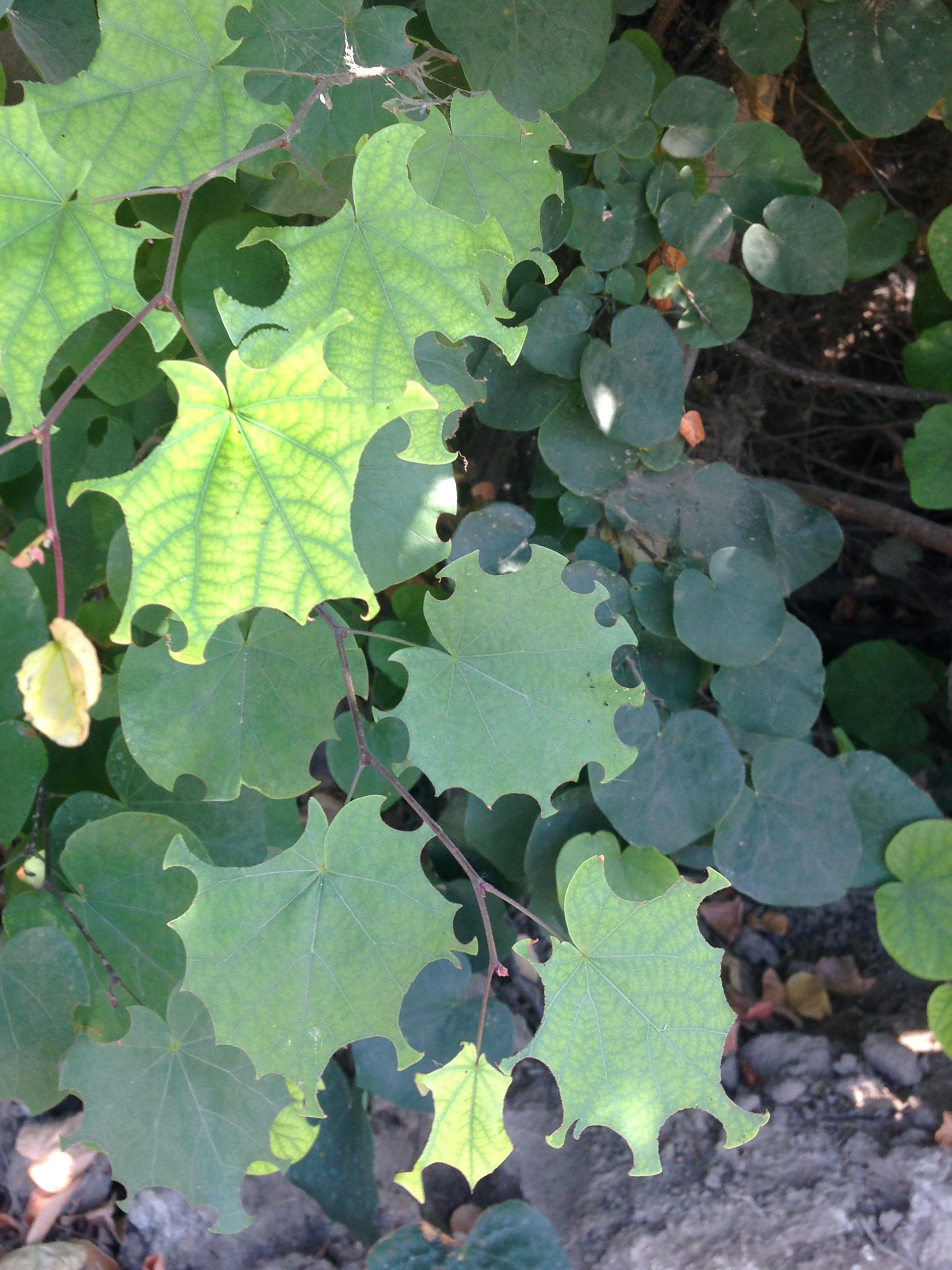
Additional Resources
Learn more about the Xerces Society’s Pollinator Conservation Program


